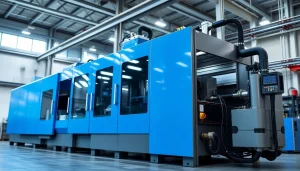Leading Blow Molding Machine Supplier for Advanced Manufacturing Solutions

Introduction to Blow Molding Technology
What is Blow Molding?
Blow molding is a special type of manufacturing process used for creating hollow plastic products. The process involves melting plastic and forming it into a mold through the application of air pressure, causing the plastic to expand and take the shape of the mold. Products created through blow molding include bottles, containers, and various other items used in both everyday life and specialized applications.
One key aspect of blow molding is its efficiency and versatility. It allows for high production rates with excellent repeatability, making it ideal for manufacturers needing consistent, high-quality output. A significant factor in this process’s effectiveness is the choice of the Blow Molding Machine Supplier which can affect both the cost and quality of the final products.
Types of Blow Molding Processes
There are three primary methods of blow molding, each with its unique characteristics and applications:
- Extrusion Blow Molding (EBM): In this process, a continuous parison (a hollow tube of melted plastic) is extruded into a mold. The mold closes around the parison, and air is blown inside, expanding the plastic to fill the mold. EBM is commonly used for producing containers and large plastic items.
- Injection Blow Molding (IBM): This method combines injection molding and blow molding techniques. Initially, molten plastic is injected into a mold to form a preform. This preform is then transferred to a blow mold, where air is introduced to shape it into its final form. IBM is excellent for creating precise, high-quality containers with intricate designs.
- Stretch Blow Molding (SBM): This technique is primarily used for making PET bottles. It involves stretching a preform both vertically and horizontally, followed by blowing it into the final shape. This results in a stronger bottle with improved clarity and aesthetics.
Applications of Blow Molding in Different Industries
Blow molding technology is used across a variety of industries due to its adaptability and efficiency. Here are a few notable applications:
- Packaging: This is by far the largest application. Blow molding is widely used for producing bottles, jugs, and containers for beverages and other liquids.
- Automotive: Components such as fuel tanks and air ducts are manufactured using blow molding to optimize weight and design.
- Consumer Goods: Products like toys, household items, and even furniture can be crafted with blow molding techniques, providing producers with lighter and more durable items.
- Medical Devices: In the healthcare sector, specific applications include creating medical containers and devices where precision and cleanliness are paramount.
Choosing the Right Blow Molding Machine
Factors to Consider When Selecting a Supplier
Choosing the right blow molding machine supplier is crucial for ensuring operational efficiency and product quality. Manufacturers should consider several key factors:
- Experience and Reputation: A supplier with a proven track record in the industry can often provide insights and technologies that newer suppliers may not possess.
- Technical Support: Inquire about the technical assistance available post-purchase, including training, troubleshooting, and maintenance services.
- Range of Products: Look for a supplier that offers a variety of machines for different applications, as well as customization options to meet specific needs.
- Reviews and Testimonials: Research existing clients’ feedback on the supplier’s products and after-sales service.
Understanding Machine Specifications and Features
It’s essential to evaluate the specifications and capabilities of blow molding machines before making a purchase. Key specifications to consider include:
- Production Capacity: Depending on production needs, the machine’s output rate can greatly influence operational efficiency.
- Mold Size Compatibility: Ensure that the machine can accommodate the size of molds required for your products.
- Energy Efficiency: Higher efficiency can translate into lower operational costs, making energy consumption a critical factor.
- Automation Features: Automated features enhance ease of use and can significantly reduce labor costs and the likelihood of errors.
Cost vs. Quality Analysis
When purchasing blow molding machines, manufacturers often face a trade-off between cost and quality. While lower-priced machines may seem attractive initially, they may lack durability, support, and necessary features. Here’s a comprehensive approach to navigating this balance:
- Long-term Investment: Evaluate the lifecycle cost of the machine rather than just the upfront price. Higher-quality machines may have a higher initial cost but lower maintenance and operational costs over time.
- Warranty and Support: Machines that come with extensive warranties and responsive customer support may justify their premium pricing.
- Performance Metrics: Analyze performance metrics such as cycle times, energy consumption, and output quality to determine the true value of the investment.
Top Blow Molding Machine Suppliers in the Market
Industry Leaders and Their Innovations
Several suppliers lead the blow molding machine market, each contributing innovative technologies and solutions:
- Uniloy: Known for its diverse technologies in blow molding, Uniloy stands out for providing solutions tailored to client-specific requirements.
- Parker: With a reputation built over 30 years, Parker integrates extensive features into their machines, ensuring longevity and efficiency.
- Bekum: Focusing on compact solutions, Bekum’s machines are designed for flexibility and quick mold changes, catering specifically to evolving production needs.
Comparative Analysis of Top Competitors
When considering potential suppliers, a comparative analysis can help assess who best fits your needs:
| Supplier | Key Features | Market Focus |
|---|---|---|
| Uniloy | Diverse technologies, customization | Packaging and Industrial |
| Parker | Energy-efficient, high capacity | Consumer Goods |
| Bekum | Compact design, rapid mold change | Automotive and Medical |
Customer Testimonials and Case Studies
Understanding real-world applications through customer testimonials can provide insights into product satisfaction and supplier reliability. Here are a few examples:
- Case Study – Parker: A beverage company reported a significant increase in output and product consistency after switching to Parker machines, citing efficiency improvements of up to 30%.
- Testimonial – Uniloy: A packaging manufacturer praised Uniloy’s customer service and support throughout the installation and training processes, highlighting how it helped integrate their new machines smoothly.
Maintaining and Optimizing Blow Molding Machines
Regular Maintenance Best Practices
To ensure the longevity and performance of blow molding machines, regular maintenance is necessary. Key practices include:
- Scheduled Inspections: Regularly scheduled checks can prevent minor issues from escalating into major problems.
- Lubrication: Properly lubricating moving parts can reduce friction and wear, thereby extending machine life.
- Cleaning: Regular cleaning prevents plastic build-up that can hinder performance.
Upgrading Machines for Enhanced Performance
As technology progresses, upgrading existing machines can yield significant performance improvements. Here are some considerations:
- Software Updates: Keep machine software up to date for optimal performance and security.
- Automation Integration: Modern machines can be enhanced with automation tools, making operations more efficient and reducing manual errors.
- Upgraded Components: Replacing outdated parts, such as motors or controllers, can boost efficiency.
Troubleshooting Common Issues
Recognizing and efficiently addressing common issues in blow molding can save time and costs:
- Inconsistent Output: Analyze settings and ensure proper calibration to resolve variations in product quality.
- Machine Downtime: If frequent breakdowns occur, consider whether it’s due to inadequate maintenance or if the machine has reached the end of its productive life.
- Material Issues: Ensure that the raw materials used meet the necessary specifications for seamless production.
Future Trends in Blow Molding Technology
Sustainability Initiatives in Blow Molding
Today, the push for sustainability is reshaping manufacturing practices, including blow molding. Key trends include:
- Recycled Materials: Many manufacturers are integrating recycled plastics into their blow molding processes, which not only meets regulatory standards but also appeals to environmentally-conscious consumers.
- Energy-Efficient Technologies: New machine designs are focusing on energy efficiency, reducing not only costs but also the carbon footprint of production.
- Bioplastics: The rise of bioplastics offers another sustainable material option that can be used in blow molding processes.
Advancements in Automation and AI
Automation and AI are increasingly being integrated into blow molding processes for efficiency:
- Predictive Maintenance: AI-driven analytics can predict when maintenance should occur, minimizing downtime and maintenance costs.
- Smart Manufacturing: IoT-enabled machines allow for real-time monitoring and adjustment, leading to enhanced performance and quality control.
- Enhanced Robotics: Robotics are being used for classifying, sorting, and packing completed products, greatly reducing labor costs.
Predictions for Industry Growth and Changes
As industries evolve, the blow molding market is expected to grow significantly. Analysts predict:
- Increased Demand: With consumer preferences shifting towards packaged products, demand for blow molding machinery will rise.
- Geographical Expansion: Emerging markets are expected to increase their adoption of blow molding technologies as consumer bases grow.
- Technological Innovations: Continued investment in R&D will likely lead to innovative technologies that further enhance product efficiency and sustainability.





